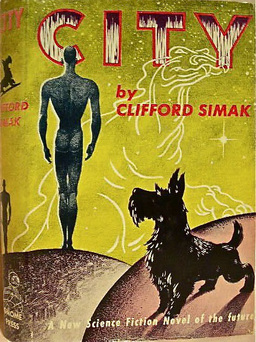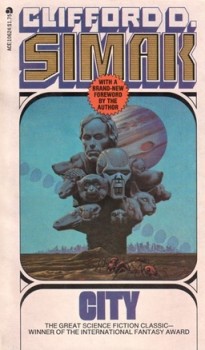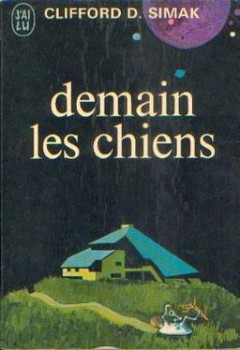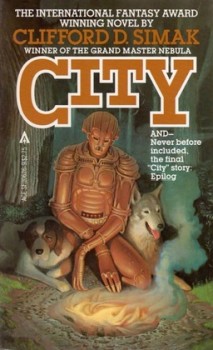“A World Gone to the Dogs”: City by Clifford D. Simak
These are the stories that the Dogs tell when the fires burn high and the wind is from the north. Then each family circle gathers at the hearthstone and the pups sit silently and listen and when the story’s done they ask many questions:
“What is Man?” they’ll ask.
Or perhaps: “What is a city?”
Or: “What is a war?”
from the Editor’s Preface to City
 City (1952), by Clifford D. Simak, unfolds over thousands of years, telling of the end of humanity, the rise of dogs and robots to terrestrial preeminence, and finally, the near abandonment of Earth. It’s a fix-up of nine stories, eight written between 1944 and 1951, and one more, added to later editions, in 1973. It is a book conceived of in anger and despair, yet one that strives to posit a better, more humane world — even if it’s one devoid of humans.
City (1952), by Clifford D. Simak, unfolds over thousands of years, telling of the end of humanity, the rise of dogs and robots to terrestrial preeminence, and finally, the near abandonment of Earth. It’s a fix-up of nine stories, eight written between 1944 and 1951, and one more, added to later editions, in 1973. It is a book conceived of in anger and despair, yet one that strives to posit a better, more humane world — even if it’s one devoid of humans.
Perhaps because we, by which I mean the post-WW II generations, have grown up aware of the deepest, most evil tendencies of humanity, it’s difficult to appreciate completely the anger and despair over what happened during the 1930s and 40s. Years after its publication, Simak said:
“The series was written in a revulsion against mass killing and as a protest against war.”
That revulsion was so intense that Simak contemplated the extinction of his own species and its replacement by a better one.
I suppose following the First World War, there was some hope that humanity would avoid that sort of mass slaughter again. Instead, it only increased by many magnitudes. In an essay on City, Robert Silverberg wrote that the story “Desertion” was written in 1943 in direct response to reports from Europe about the Holocaust. Simak was a gentle writer, so there is little anger or bitterness in the novel, but he wasn’t prone to sentimentality either. His depiction of humanity’s downfall and supplantation is remorseless.
When Simak collected the stories, he presented them as a tales told by dogs to each other as perhaps no more than legends. For each story, Simak wrote an interstitial explaining what different dog philosophers thought about the veracity of each story, as well as any meaning it might hold for their society.
The first story, “City,” presents a 1990 drastically different from how it really turned out. Advances in atomic power, cheap construction techniques, and hydroponics have freed humans from the close-packed confines of cities. Large parcels of land and affordable houses have lead to a massive exodus from urban centers. Only politicians, a few businessmen, and some eccentric holdouts remain.
 It’s clear from much of Simak’s fiction, he had a preference for sparsely populated rural places. So it would seem this outcome is a blessing for the world. As the book progresses, though, some humans evolve to the point of being incapable of reaching out to anyone else. Later, Simak writes that it’s social pressure that keeps humanity together and advancing. When that’s gone, humanity begins to fade. The story “City” turns on a conflict between the politicians and the holdouts, and the return of one of the famous Webster clan to his home town.
It’s clear from much of Simak’s fiction, he had a preference for sparsely populated rural places. So it would seem this outcome is a blessing for the world. As the book progresses, though, some humans evolve to the point of being incapable of reaching out to anyone else. Later, Simak writes that it’s social pressure that keeps humanity together and advancing. When that’s gone, humanity begins to fade. The story “City” turns on a conflict between the politicians and the holdouts, and the return of one of the famous Webster clan to his home town.
“Huddling Place” is the first indication of humanity’s failing. Jerome Webster is the most talented of the few surgeons familiar with Martian physiology. When his friend, the great Martian philosopher Juwain, is injured and in need of immediate brain surgery, Jerome is the only one who can save him. Unfortunately, he finds himself unable to leave his family compound.
This tale introduces Jenkins, the Webster family robot-butler. Just as he presides over the human home here, he will eventually do the same for the dogs as their society arises. By book’s end, only he knows the real truth of the fall of man and the rise of dogs.
Dogs are finally introduced in “Census Taker.” It has come to the attention of the world government that out in the wilds, mutants with strange talents have arisen. Richard Grant is one of the people sent out to investigate them and their activities. His travels bring him to the Webster compound, where he finds the family has been uplifting dogs, giving them speech and cognition. He also meets the mutant, Joe, who has done the same thing with ants.
The ants were pulling carts. And there were chimneys sticking from the hill, chimneys that belched tiny, acrid puffs of smoke that told of smelting ores.
Head throbbing with excitement, Grant squatted beside the next, staring at the carts that trundled along the roads leading off into the grass-roots land.
 While the Websters have taken their actions out of genuine love of dogs, and the desire to create a race to grow alongside man, Joe has uplifted the ants for the heck of it. His actions will echo across the millennia.
While the Websters have taken their actions out of genuine love of dogs, and the desire to create a race to grow alongside man, Joe has uplifted the ants for the heck of it. His actions will echo across the millennia.
The fourth story, “Desertion,” is probably Simak’s most famous. It ends with one of the most poignant and bittersweet lines in perhaps all of science fiction.
Kent Fowler is in charge of one of the exploration domes on Jupiter’s surface. For months, he has been converting men into lopers, the toughest of Jupiter’s native species. Not one of those he’s sent out has returned. Unwilling to abandon his work or forget the sacrifice of his team, he and his dog, Towser, enter the converter together. What he discovers on the Jovian surface is not what he had imagined:
It was not the Jupiter he had known through the televisor. He had expected it to be different, but not like this. He had expected a hell of ammonia rain and stinking fumes and the deafening, thundering tumult of the storm. He had expected swirling clouds and fog and the snarling flicker of monstrous thunderbolts.
He had not expected the lashing downpour would be reduced to drifting purple mist that moved like fleeing shadows over a red and purple sward. He had not even guessed the snaking bolts of lightning would be flares of pure ecstasy across a painted sky.
This is the story that showed me that science fiction could be so much more than rockets and rayguns. It was, and remains, one of my favorite stories of any genre.
The aftermath of Fowler’s excursion on Jupiter is explored in “Paradise.” After five years, he returns to Earth to tell the rest of humanity about the amazing things he discovered living as a loper; senses and beauty beyond any human descriptions. Tyler Webster fears Fowler’s message will entice most of humanity to follow him back to Jupiter just as they have reached a place of sustained peace and cultural growth. The only way he can think of to stop Fowler is to kill him, but there’s been no murder in the Solar System for over a century.
Between “Desertion” and “Paradise,” Simak’s humanity is a species that is simultaneously striving for new discoveries and ready to chuck it all. Besides the Jupiter explorations, there are efforts being planned to reach Alpha Centauri, and to develop life on Pluto. Colonies seem to have been planted on Venus as well. We never see the immediate reaction of people to Fowler’s message, but by the next story, it’s obvious that Webster’s fears were justified. Bold and strong-willed as humanity is, they will forego everything for an immediate heaven.
Centuries have passed by the time of the next tale, “Hobbies.” Dogs, with attendant robots to serve as hands, have developed their own civilization. They are also trying to lift up the other animals of Earth. Most of humanity left ages ago for the paradise of Jupiter, leaving their robot servitors behind. Only five thousand humans remain in the domed city of Geneva. Most, though, have grown bored of their lives and retreated into hibernation tanks and induced dreams. Simak describes humanity with a line that seems woefully appropriate for today:
Man gave up trying. Man enjoyed himself. Human achievement became a zero factor and human life a senseless paradise.
 When Jon Webster takes a nostalgic trip to the old Webster compound, he realizes the wonderful possibilities of the peaceful civilization the dogs are building and decides only their complete isolation from humans will guarantee its success. No matter how benign the remaining humans may be, Simak seems to say, they are still too dangerous. This attitude is only reinforced in the following story, “Aesop.”
When Jon Webster takes a nostalgic trip to the old Webster compound, he realizes the wonderful possibilities of the peaceful civilization the dogs are building and decides only their complete isolation from humans will guarantee its success. No matter how benign the remaining humans may be, Simak seems to say, they are still too dangerous. This attitude is only reinforced in the following story, “Aesop.”
In “Aesop” we learn the dogs have been developing psychic abilities. Earlier, it’s been implied they were there all along, but now they’ve been pushing them further. They have discovered multiple dimensions and are trying to figure out how to travel between them and face the dangerous things, cobblies, that slip over from them into Earth occasionally. When one does, it comes up against one of the few remaining wild humans, now simply called websters by the animals. That showdown convinces Jenkins, once and for all, that there is no room on Earth for humans alongside dogs.
The original closing story, “The Simple Way,” fills us in on what’s happened with the abandoned robots and the ants over the ages. The robots have emulated their creators, focusing on rational means to explore the universe. The ants are imponderable and cannot be communicated with by anyone else. They expend all their efforts on building an ever-growing building, subverting robots with little ant-sized ones that bore into their skulls and reprogram them to do the heavy lifting.
Now that all animals have become intelligent and all the carnivores live on vat-grown meat substitutes, the population of Earth is exploding. To face this, the dogs have implemented a lottery to choose who will leave to settle other universes.
When it becomes increasingly clear the ants will eventually build over all of the planet, a solution is sought. It turns out to be one no one on Earth is willing to implement any longer.
Simak wrote the final tale, “Epilog,” for the John W. Campbell Memorial Anthology. Despite a reluctance to revisit the stories, he decided it was appropriate for the collection, as all but “The Simple Way” had appeared in Astounding under Campbell’s editorship. It takes places thousands of years after the last story when, save for a five-mile diameter circle of meadow around the Webster compound, Earth has been covered by the ants’ building.
Normally, I wouldn’t have given a sketch of each story like this. I felt compelled, though, to give a sense of the strange wonders and beauty of City. With its robots, uplifted dogs, mutants, and alien creatures, it’s a science fiction story. However, there’s never any real effort to explain or explore the nature of the various technologies. Simak clearly wasn’t concerned with how the logistics of a ruralized world would really work, or that only one man could save the Martian.
What he wanted was to describe an Earth populated by a truly peaceable kingdom, where the lion would lie down with the lamb. Where mass slaughter couldn’t even be conceived of. Where a civilizaton worthy of the beauty of the fields and forests could flourish. And he did. The dog world civilization he built is one of endless curiosity, abiding affection for each other as well as their fellow animals, and real peace.
There’s no denying a deep melancholy suffuses the nine stories of City. Humanity is unable to find a path to the future short of self-annihilation. Even the utopian dog civilization isn’t enough to save the Earth from desolation and abandonment; any hope lies beyond her borders. And still, there is hope. Hope for a better universe. Hope for one where labor camps, terror bombing, and genocide can’t even be understood.
Simak wrote many good and wonderful books, but for me this stands out as his finest. If it has escaped your attention up until now, it is worth tracking down. In little more than 200 pages he spun a tale that, long after the events that prompted its creation have passed, is still hauntingly beautiful, yet resonant with great power.
Fletcher Vredenburgh reviews here at Black Gate most Tuesday mornings and at his own site, Stuff I Like when his muse hits him. Right now, he’s writing about Western movies.
One of my favorite SF novels, and “Desertion” is one of my favorite stories of any kind, thanks to that great last line.
Simak is not nearly read as much anymore as he should be; none of the great SF writers of his generation had more simple wisdom or deep humanity than he did – and not many since, either.
I have always thought that those opening lines of City are the greatest ever.
Simak remains one of my favorite writers, and I’ve read many of the component stories of CITY in various anthologies over the years… but I’ve never actually made the effort to read them all back-to-back. Clearly that was a major oversight!
Funny, just today the postman brought an item I ordered from Amazon, an essay collection called Reflections and Refractions by Robert Silverberg. It includes essays about various science fiction writers, including an essay entitled “City: Clifford D. Simak”.
My reading group did Mr. Simak’s Way Station last year, and everyone enjoyed the pastoral atmosphere of his writing. I will have to introduce them to City at some point, too.
Great rundown of a great book. Simak is definitely out of fashion, but still a favorite of mine–now more than ever, maybe. I hear that judicious editor’s voice in my head whenever I talk or think about mythology (which is a lot).
I’d like to have that edition that includes “Epilog” in its rightful place, as the crowning story in the book, rather than the rather disappointing “The Trouble with Ants”/”The Simple Way”. I always have to dig up my copy of the JWC anthology after I’ve finished a reread.
@Bill C.- I was very happy it moved me as much as it did on previous readings.
@Thomas P. – He isn’t, but it seems when new readers find him they are as entranced as many of us who grew up on him.
@John – Unbelievable! 😉 The foreword makes a good case for the importance of the book as a whole and the interstitial chapters in making it so.
@Amy B.- it’s a good read
@Eugene R. – That’s good to hear.
@James E. – Thanks. What disappointed you about “The Simple Way?”